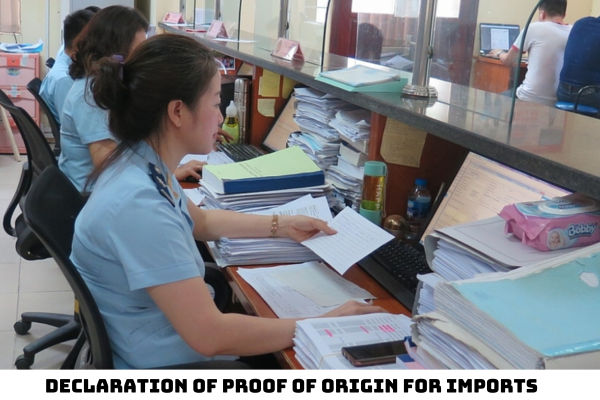What are the instructions for declaration of proof of origin for imports when following the customs procedures in Vietnam?
- What are the instructions for declaration of proof of origin for imports when following the customs procedures in Vietnam?
- What are the cases in which customs declarants must present proof of origin for imports in Vietnam?
- What are errors to which the customs authority will still accept the proof of origin of imports in Vietnam?
What are the instructions for declaration of proof of origin for imports when following the customs procedures in Vietnam?
According to the provisions of Article 11 of Circular 33/2023/TT-BTC, the declaration of proof of origin for imports is specifically guided as follows:
Case 1: A proof of origin is submitted when following customs procedures:
- The customs declarant shall declare the reference number and issue date of C/O or a number of the exporter eligible to make out an origin declaration (REX number under EVFTA Agreement, EORI number under UKVFTA Agreement, CE number under ATIGA or RCEP Agreement) in the “Notes” box of electronic customs declaration or the “Attached documents” box of physical customs declaration.
If the relevant FTA contains no provisions on reference number and/or the number of the exporter eligible to make out an origin declaration is not available, the customs declarant shall declare the name, number, issue date and name of the organization or the exporter issuing the proof of origin or making out the origin declaration and name of the relevant FTA.
Case 2: If an imported good is supported by a notice of origin pre-determination results which is issued by the General Department of Vietnam Customs and still valid, the customs declarant shall declare the number and issue date of that notice in the “Notes” box of the electronic customs declaration or the “Attached documents” box of the physical customs declaration.
Case 3: Where the quantity of imported good is monitored on a C/O, the customs declarant shall declare the issue date and issuing body of the import quantity monitoring sheet in the “Notes” box of the electronic customs declaration or the “Attached documents” box of the physical customs declaration.
Note: The customs declarant shall be allowed to make additional declaration of information on the proof of origin if such information is not provided or has been incorrectly provided when following customs procedures.

What are the cases in which customs declarants must present proof of origin for imports in Vietnam?
Under Clause 5, Article 12 of Circular 33/2023/TT-BTC on the time limit for submission of proof of origin for imports:
Time limit for submission of proof of origin for imports
...
5. The customs declarant shall retain original copies of proofs of origin and present them to customs authorities upon post-clearance inspection, specialized inspection or customs inspection or in case the validity of the proof of origin is suspected by the customs authority while processing customs procedures.
Where the customs declarant fails to present the proof of origin, the customs authority shall carry out verification procedures and take actions as prescribed in Article 19 of this Circular.
...
Thus, customs declarants must present proof of origin for imports in Vietnam in the following cases:
- Customs declarants must present proof of origin for imports to customs authorities upon post-clearance inspection;
- Customs declarants must present proof of origin for imports to customs authorities upon specialized inspection or customs inspection;
- The validity of the proof of origin is suspected by the customs authority while processing customs procedures.
What are errors to which the customs authority will still accept the proof of origin of imports in Vietnam?
Under the provisions of Clause 8, Article 15 of Circular 33/2023/TT-BTC, the customs authority shall accept the proof of origin in cases where there are minor errors or discrepancies between the proof of origin and other documents included in the customs dossier, if they do, in fact, correspond to the goods imported. Such errors and discrepancies include:
(1) Spelling or typing errors that may not affect the authenticity of the information included in the proof of origin;
(2) Differences in tick marks in boxes on the C/O: either manual or typewritten, including crossed (“x”) instead of ticked (“√”);
(3) Slight discrepancies in the authorized signature in the proof of origin and the specimen signature;
(4) Different units of measurements stated in the proof of origin and other documents included in the customs dossier (such as customs declaration, invoices and bill of lading);
(5) Differences in paper size between the C/O submitted to the customs authority and the prescribed sample C/O;
(6) Minor discrepancies in ink colour of the text on the proof of origin;
(7) Differences in HS codes: conformable at 6-digit subheadings but different at 8-digit level;
(8) Differences in name and number of shipment due to change of means of transport;
(9) Slight differences in the description of goods in the proof of origin as compared to other supporting documents;
(10) Other slight discrepancies as defined in the relevant international agreement or convention to which Vietnam is a signatory and notified by the General Department of Vietnam Customs.
LawNet